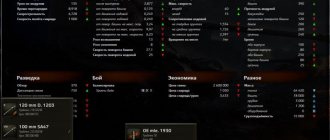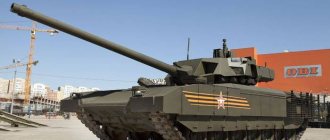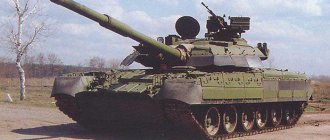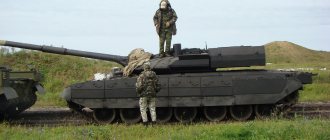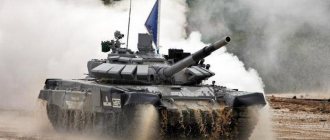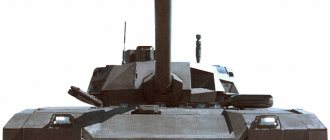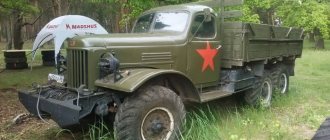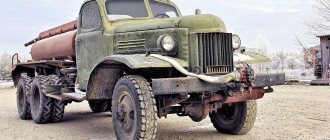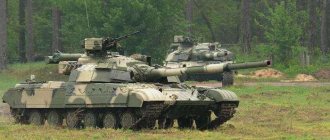With the development of information technology, the doctrine of warfare has changed. The emphasis began to be placed not on massive strikes and concentrations of troops, but on tactical data exchange and the use of high-precision weapons.
Based on a similar concept, the United States developed the doctrine of network-centric warfare. Its key aspect is to coordinate the actions of units, exchange information in real time and effectively carry out strikes. The principles of this doctrine are adopted by other states, including Russia.
T-14 Armata is a Russian main battle tank developed within the framework of the concept of network-centric warfare. Designed for action as part of a group, reconnaissance, adjustment and fire control. Significant emphasis is placed on the communication equipment of the machine.
The history of the creation of the Armata tank
The T-14 "Armata" model belongs to the 4th generation tanks. It attempts to implement the idea of an uninhabited tower and a network-centric concept. Tanks are capable of participating in the actions of an entire tactical unit subordinate to one integrated control system. In the future, they can be equipped with devices with artificial intelligence that provide automatic operation.
The developer of the tank is OJSC Uralvagonzavod, which used the best developments of the USSR and the Russian Federation in the field of tank building. Work began in 2010 and was based on the T-95 tank project. In the new machine, for example, its carriage principle of a tower layout is applied. The design was carried out in a short time, in conditions of fierce competition with the American program “Combat Systems of the Future”.
The developers were tasked with creating the main vehicle for armored forces. The basis was the universal platform "Armata", on which not only tanks, but also armored personnel carriers, infantry fighting vehicles, self-propelled guns, combat support vehicles, etc. can be based. Already in 2022, such equipment began to enter the troops. At the same time, network-centric complexes were created, including T-14 tanks, T-15 heavy-duty infantry fighting vehicles, Coalition-SV self-propelled guns, and attack helicopters. The tank went into mass production and was first presented at the Victory Parade in 2015.
Comparison of Armata with other tanks
Comparison of characteristics with foreign analogues
Comparing the T-14 with modern tanks, Western experts agree that the Armata belongs to the next generation. There are a number of advantages and developments that are combined for the first time in the design of one machine.
Thus, the Israeli Merkava tank also has an AFAR radar capable of calculating the firing position of an incoming projectile. However, the latter does not have the ability to reflect ammunition, and its frontal armor is weaker. Taking into account the location of the engine in the front part of the hull, penetration of the frontal protection is almost guaranteed to disable such a vehicle.
British experts also express concerns about the ability of their own vehicles to engage in confrontation with the Armata. The current Challenger 2 is not capable of penetrating the armor of the T-14, which requires its urgent replacement.
The German Ministry of Defense put forward a similar assessment of Armata. According to his assessment, Leopard-2 is not capable of penetrating the armor of the T-14. Based on this aspect, a Franco-German concern was created to jointly develop a new modern tank.
Chinese developers are confident that their VT-4 is superior to the Armata, although they point to the better transmission of the T-14. At the same time, the government is considering the possibility of purchasing Russian tanks.
There are no official statements from the United States, however, according to experts and various news publications, the American Abrams is also inferior to the Armata in a number of parameters. An opinion is expressed about its modernization and its ability to be the first to detect the enemy, which increases its chances of survival.
Tactical and technical characteristics of the T-14 tank
In addition to the fact that the T-14 tank has significant combat power, rate of fire and shooting accuracy, it is capable of performing network-centric tasks: reconnaissance, target designation, remote control through a unified control system. In combat conditions, the vehicle receives operational data online and provides automatic determination of ballistic parameters for fire control of the entire tactical unit.
Main advantages of the tank:
- use of a universal platform;
- placement of tankers in an armored capsule, separate from the ammunition compartment;
- possibility of operation with an uninhabited tower;
- the use of pulse-Doppler type radar, which reliably and quickly determines the target’s velocity vector;
- active protection capable of protecting against various types of ammunition.
Main performance characteristics of the tank:
- weight in combat configuration - 48 tons;
- crew size – 2-3 people;
- multi-layer armor with complex protection "Afganit" and dynamic protection "Malachite";
- engine power – 1600 l. With.;
- travel speed on the highway – up to 90 km/h, off-road – 70-75 km/h;
- driving range (highway) – at least 500 km;
- firing range – up to 8 km;
- possibility of shooting while moving;
- ammunition - 45 shells.
The tank is equipped with a system for launching and controlling the Pterodactyl unmanned aerial vehicle, which has an autonomous radar and an infrared sight. The drone's mission includes reconnaissance and target designation.
Location of components and modules of Almata
0
The engine, transmission, as well as the automatic loader with ammunition are isolated from each other, which dramatically increases the survivability of the Almata even if the armor of the turret or engine/transmission compartments of the tank is penetrated. That is, if there is no direct hit in the compartment with ammunition and an automatic loader, then there will be no detonation of the ammunition. Even with multiple penetrations of the tank, the armored capsule will protect the crew and fire control systems, allowing the robotic uninhabited turret to fire. Another original solution is that the crew is positioned in a row, which reduces the area of the side projection of the manned armored capsule, sharply reducing the likelihood of being hit.
0
The T-14 tank uses a new mine-resistant V-shaped armor; remote mine detectors are installed on the tank, which are connected to an anti-tank mine destruction system, which allows the tank to overcome minefields.
T-14 design
The tank has a classic layout of the main elements, when the power plant (engine-transmission compartment) is located in the rear, aft part of the vehicle. In front there is a control compartment with seats for the crew, instruments and control devices. The combat compartment is in the center. There is a turret, a compartment with ammunition and a device for automatic loading.
Platform, powertrain and suspension
The basis of the tank is the Armata heavy-category tracked transforming platform. This development of Uralvagonzavod can be used in other types of heavy armored vehicles. Versatility is ensured by a modular design, when elements can be transferred to different areas, changing the layout.
The power plant is equipped with a diesel X-shaped engine type A-85-3A (12N360) manufactured by ChTZ. It has 12 cylinders. Power can vary in the range of 1100-1600 hp. With. A specific power of 31 hp is achieved. With. for every ton of mass. An important feature is the speed of engine replacement, which is necessary in combat conditions. For such an operation 30 minutes is enough.
The T-14 tank uses active suspension. It is based on seven rollers mounted on bladed shock-absorbing elements. The shock absorbers are equipped with a differential rotary mechanism with a hydraulic volume amplifier. Special sensors allow you to detect uneven terrain and send a signal to the vertical movement of the rollers. The active suspension principle eliminates strong swaying of the vehicle when moving over uneven surfaces, which significantly speeds up target acquisition by the electronic guidance system. Compared to previous tanks, the target acquisition time is reduced by 2.3 times, and the destruction time is reduced by almost 1.5 times.
The chassis includes an automatic transmission with the ability to switch to manual gear shifting. There are eight gears in the forward and rear directions (16 gears in total). The power reserve is ensured by spacious fuel tanks of an improved design. They are hidden under armor and have a shield against cumulative damage, while they themselves cover the engine, increasing its protection. The exhaust pipes are located so that the exhaust gases disrupt the visibility of the tank in the infrared spectrum.
The platform is equipped with an electronic information and control system. It signals the occurrence of problems in the engine and running components, the need for repairs, and diagnoses violations.
Video: animated video with performance characteristics and an overview of the capabilities of the T-14 Armata tank
Design
The tank was created using the designs of the Object 195 and Object 640 tanks, inheriting from them, among other things, the “carriage layout”. In May 2015, General Director of Uralvagonzavod Oleg Sienko said that the tank was developed in two years, tests will take place within a year.
Engine and chassis
Engine and speed characteristics
The machine is equipped with a 12-cylinder four-stroke X-shaped turbocharged diesel engine A-85-3A (12N360) with a power of 1500 horsepower, a minimum service life of 2000 hours (1500 hp). The 12N360 multi-fuel engine, with direct injection, was developed by the Chelyabinsk design bureau "Transdiesel" and produced by the Chelyabinsk Tractor Plant. The gearbox is automatic with the ability to manually shift. Weighing 48 tons, the tank with a 1,500-horsepower engine has a maximum speed of up to 90 km/h. Foreign tanks with an engine of similar power and a weight of 54.6 to 68.5 tons accelerate to 67-72 km/h (Leclerc, M1A2 Abrams, Leopard-2A7) since the specific power is lower.
Engine replacement is carried out in 1 hour.
Active suspension and chassis
Seven-wheel active suspension on vane shock absorbers with a differential steering mechanism with hydrostatic transmission. The active suspension eliminates the swaying of the tank during movement, which improves the time of target acquisition by optical-electronic means by 2.2 times and reduces the time of hitting a tank-type target by 1.45 times.
The chassis roller has a diameter of 700 mm (as evidenced by the engraving on the rubber tire of the roller). Due to its lower mass compared to the T-72 roller, the weight of the tank's suspension is one ton less than that of the Object 195.
Tank information and control system
The T-14 is equipped with a tank information and control system (TIUS), which monitors all components and assemblies, controls on-board systems, and diagnoses faults, which allows the driver to control the engine and chassis without leaving the armored capsule for diagnostics. In the event of a breakdown, it will not be the crew or the repair team who will decide what needs to be repaired, but the electronics.
The tank commander can perform the functions of a driver from his seat.
Armament
The tank is armed with a main gun with a combat rate of fire of 10-12 rounds per minute and a target engagement range of 7-8 km. Additionally armed with an anti-aircraft machine gun and a 7.62 mm machine gun. Can use a 30 mm anti-aircraft gun instead of a 12.7 mm machine gun, and can use anti-aircraft missiles. It is possible to use both 152 mm and 125 mm tank guns.
Sighting system
According to the terms of reference of the Ministry of Industry and Trade for the purchase of the T-14, the tank will be the first in the world to use an active phased array radar made using the same technology as the fifth-generation fighter T-50 in low-temperature ceramics for the Ka-band 26.5-40 GHz . In the manufacture of the radar, LTCC technology was used for the manufacture of MW radar panels, when the electronic components are actually located in molten glass. The advantage of LTCC technology is traditionally a significant reduction in the cost of MW devices with high electronic and mechanical characteristics. Four glass LTCC radar panels are clearly visible on the T-14 turret. Many sources state the performance characteristics of the radar as a targeting radar capable of simultaneously tracking 40 ground and 25 air targets at a distance of up to 100 km. The radar also allows the tank to be used as an artillery reconnaissance radar, determining the positions of enemy tanks and artillery from the trajectories of projectiles, and also to fire in modern combat conditions with mutual blinding of opponents by aerosol multispectral curtains, when conventional optical and infrared guidance devices become useless. Experts from foreign magazines on defense topics, such as Defense Update and Jane's 360, take a balanced point of view, pointing out the presence of AFAR radar panels in photographs of the T-14, while noting that its exact characteristics are known only from statements by officials and are not confirmed by sources independent of them .
According to a review from the VPK website, the T-14 sighting system includes:
- The main gunner's sight is multi-channel with sighting and thermal imaging channels, a laser rangefinder, and a built-in laser control channel. Magnification of the viewing channel, magnification - 4; 12.
- Recognition range of a "tank" type target through the sighting channel, m - up to 5000.
- Recognition range of a “tank” type target through the TP channel, m, at least 3500.
- The maximum range measured by the rangefinder, m - 7500.
- Recognition range of a “tank” type target via a TV channel, m up to 5000.
- Recognition range for tank-type targets, m: during the day, at least 2000,
- Ballistic computer with a set of weather and topographic sensors and an electronic digital barrel bending sensor
- The ability to automatically track targets is provided independently from the gunner's position and from the commander's position with the implementation of the "hunter - shooter" mode.
- An improved two-plane weapon stabilizer with an electromechanical GN drive and an electrohydraulic VN.
Information from television, laser and thermal imaging sensors about the combat situation is displayed on the tank's monitors; a panoramic view allows the commander and gunner to see the battlefield at 360 degrees. The tank is also equipped with a hydropneumatic cleaning system for surveillance devices.
Automated combat systems
Unlike traditional tanks, the T-14, like all combat vehicles of the Armata family, is not intended for single combat, but to work with a group of different combat vehicles in one tactical unit, performing the function of reconnaissance, target designation and remote control through the ESU TZ system (unified tactical level control system) of the Sozvedie concern, which allows all Armata vehicles to receive the operational situation in real time and automatically calculate ballistic data for fire control systems in the scenario of hitting targets not with one Armata, but attacking the target with the whole group together. Due to the AFAR radar of the T-14, an army reconnaissance and target designation complex is positioned at the tactical level. Direct destruction of targets can be carried out not by the T-14, but by the armored fighting vehicle of its tactical level. For example, the T-15 with missile attacks and anti-aircraft fire or the Koalitsiya-SV self-propelled gun with a “flurry of fire.” To fire the T-14 using another armored fighting vehicle, design changes are made to them, in particular, all infantry fighting vehicles on the Epoch combat module (T-15, Kurganets-25) received fully remote fire control, including in capture and tracking mode goals. Uralvagonzavod, through its Technowars magazine, reported that it plans to make the T-14 itself remotely controlled and capable of fighting without a crew. The tank commander can control all the tank’s weapons from his seat.
The FCS (Fire Control System) is connected to the equipment of the system for setting up aerosol and smoke screens and the equipment of the “Friend or Foe” identification system (similar to the one installed on the “Object 195”; this FCS is an improved version of the FCS of the T-95 tank).
gun
The first copies of the tank were equipped with a 125 mm 2A82-1M smoothbore gun (in an uninhabited turret, with fully remote digital control), developed by Plant No. 9, and has the ability to fire on the move. The new automatic loader is separated from the crew, with “removal of ammunition” (which allows saving the life of the crew even if the shells detonate), the gun will be controlled from an isolated armored capsule. The ammunition load contains up to 32 guided projectiles for various purposes. Unlike other 125 mm tank guns, the gun on the T-14 is much more compact due to the lack of a gas exhaust system due to the uninhabited nature of the turret, and also has a sensor for barrel bending due to heating for taking into account in ballistic calculations (fixed in a small container above the barrel ).
Production T-14s can also be equipped with the 152 mm 2A83 gun developed for the T-95. In a direct fire tank firing scenario, the 2A83 gives a direct shot range of 5100 meters with penetration of more than 1 meter of homogeneous armor; for comparison, the M1 Abrams has a firing range of armor-piercing shells of 2000 meters and frontal armor of 0.7 meters (M829A2), some M1A2SEP tanks can use M829A3 with a potential of 100 mm more. The 2A83 gun was partially developed on the basis of the 2A65 152 mm towed howitzer gun, but unlike it, it is smooth-bore and with a chrome coating to achieve a higher pressure of 7700 atm and more than 2 times higher projectile speed for firing sub-caliber ammunition, also The bolt system for the T-14 automatic loader has been changed relative to the 2A65. The 2A83 gun is capable of firing 152 mm cluster and thermobaric shells, while the accuracy of fire at long ranges of the T-14 will of course be inferior to specialized self-propelled guns with rifled barrels. From the Msta-S arsenal, the T-14 will also be able to use Krasnopol guided missiles (HEAT and high-explosive fragmentation) with a nominal range of 20 km. Lev Romanov points out the possibility of using advanced radar-controlled ammunition. Member of the expert council of the Board of the Military-Industrial Commission of the Russian Federation Viktor Murakhovsky believes that the T-14 can easily be converted from 125 mm to 152 mm variant due to the modularity of the Armata platform and with a 152 mm gun classifies the T-14 as a heavy “breakthrough tank” , since the T-14 will have an overwhelming advantage over traditional tanks.
Also, special versions of guns based on new electro-thermochemical principles (ETCP) are being developed for the tank. In particular, for the first time, specialists from the nuclear weapons complex, namely Rosatom, were attracted to develop ammunition for these guns. As a result of the creation of high-explosive fragmentation and armor-piercing sub-caliber projectiles of increased power, it was possible to abandon the use of weaker cumulative ammunition.
Missile weapons
Like its predecessors, the T-14 will have the ability to launch missiles through the gun barrel using the next version of the Reflex-M missile system. The presence of the T-14’s ability to fire guided missiles is confirmed by an expert report from the US Department of Defense OE Watch magazine.
Many domestic experts advocate arming the T-14 with 152 caliber because of the ability to launch heavier and more powerful missiles from the barrel, including anti-aircraft ones, and perform air defense functions.
Machine gun installation
Foreign experts note that the T-14 is capable of destroying UAVs, but they call machine guns the main weapon for air defense against helicopters and expect an increase in the caliber of the anti-aircraft gun to 30 mm in the production version of the tank, similar to the Epoch combat module.
The machine gun armament consists of an anti-aircraft robotic installation with a Kord machine gun and a PKTM coaxial gun.
Protection
Booking
A multi-layer combined armor barrier is installed in the front projection, which can withstand hits from all or almost all modern and promising types of anti-tank shells and missiles. The homogeneous armor equivalent is more than 900 mm. Without taking into account active protection and stealth technologies, this level of armor is potentially vulnerable to the T-14 itself and Russian armor-piercing Hermes missiles; when firing from minimal distances without horizontal deviation, the ammunition available for a minority of Abrams and Leopard tanks can be effective; the presence of other similar anti-tank weapons of sufficient effectiveness.
The tank is covered with double dynamic protection Malachite in front of the sides and on top of both the hull and the turret (the turret in terms of the internal volume); the turret is covered on top with a capsule that provides secrecy in various frequency ranges. The tracks and hull are also covered with remote sensing blocks. Behind the turret there is a trap for cartridges and tools; it covers the MTO compartment from above.
A special feature of the T-14 is that the crew with control computers is located in an isolated armored capsule. The ammunition, engine and transmission are also isolated from each other in a kind of “armored capsule”. This not only protects the crew even in the event of detonation of ammunition, but also makes the tank unusually survivable and combat-ready even in the event of multiple penetrations of the armor, since most modern anti-tank weapons are designed to destroy the crew and sensitive electronics with fragments or drops of destructible armor and high-explosive action (damage durable equipment inside the tank from drops of armor and a high-explosive shock wave are usually small in cases of penetration by cumulative ammunition). Therefore, if, when penetrating the tank’s armor, it was not possible to directly hit the ammunition load, then the uninhabited robotic turret will continue to fire, whereas in a traditional tank the crew would be wounded and the tank would lose its combat effectiveness. It should also be noted that the armored capsule of the T-14 crew is located behind the most powerful frontal armor of the tank, while in order to radically reduce the area of the side projection of the armored capsule and reduce the likelihood of getting into it, the crew was seated in one row.
The armor of the T-14 turret consists of the main armor and the anti-fragmentation casing; the instruments on the turret are located between the armor layers. The Izvestia newspaper published what the main armor of a T-14 turret without a casing looks like. The casing protects the tank's instruments and dynamic protection modules from fragmentation damage, and is also used to reduce radio signature against the most advanced radar-guided ATGMs of the JAGM type.
For combined multilayer armor, specialists from the Research Institute of Steel have developed a new armor steel grade 44S-SV-Sh of high resistance electroslag remelting, as well as new materials and filler designs. This made it possible to reduce the weight of the structure by 15% while maintaining armor resistance. The Steel Research Institute states that the T-14's armor (apparently we are talking about frontal armor) is resistant to all anti-tank ammunition of 120 mm caliber and cumulative up to 150 mm Jane's 360 experts generally agree with this and believe that the armor of this tank satisfies the highest 5th class of armor according to the NATO classification - STANAG 4569, which means impenetrability when shooting a tank at point-blank range from 500 meters with a sabot projectile with a tungsten core of the Oerlikon-Contraves type PMB 073 at a speed of 1.3 km/sec, as well as resistance of the armor to rupture near the tank 155 mm high-explosive fragmentation projectile. Dynamic protection T-14 is created on the principle of design and configuration changes to suit the use case. On the march, dynamic protection can be removed, and additional modules can be installed for an urban combat scenario.
In the T-14, the design of additional fuel tanks was changed; for the first time for Soviet and Russian tanks, they became non-removable and recessed behind the armor and anti-cumulative shield. In this case, the tanks participate in additional protection of the engine, in the event of a hit in the tank, taking on the deformation.
In its OE Watch magazine, the US Department of Defense confirms that the T-14's armor is resistant to most modern ammunition, and the Afghanit system does have the ability to intercept even sub-caliber armor-piercing projectiles in flight.
Mine protection
The T-14 is equipped with mine-resistant V-shaped armor and remote mine detectors connected to the mine destruction system.
Active projectile protection
The T-14 is equipped with Afghanit active protection. As part of a tank (without the obligatory use of external means), the system receives data in advance about the approach of the enemy and, using stealth technologies, provides the next three stages of detection: communication system, radar, other detection means, including the active protection system devices themselves. When actively intercepting a target as part of an Armata tank, the following three phases of active interception are used: firing rockets and shells from a 12.7 mm machine gun, jamming, interception (destruction) using KAZ Afghanit counter-ammunition.
Interception of cumulative grenades, ATGMs, and sub-caliber projectiles (BPS) is ensured. Experts from the authoritative Defense Update magazine, when analyzing the Afghanit system on the T-14, indicate that it consists of damaging (hard kill) and masking (soft kill) elements. The striking elements are located in shotgun pedestals under the turret, which operate similarly to the Drozd KAZ, but more efficiently - the reaction time allows you to intercept even sub-caliber shells. Judging by the identical large Afghanit sensor on the T-14 and T-15 above the “shotguns”
The Afghanit developers also received patent RU 2263268 for an active protection system based on the “shock core” principle, which allows them to shoot down promising ammunition at speeds of up to 3000 m/s.
Active missile defense
Afghanit is very effective against all known types of anti-tank missiles.
Previously, the T-14 developers also reported that the machine gun mount, based on data from the AFAR radar, is capable of protecting the tank not only by shooting down incoming anti-tank missiles, but also having a significant probability of hitting anti-tank shells in order to change the flight path of sub-caliber shells or damage cumulative ammunition.
Stealth technologies
According to Uralvagonzavod, the T-14 uses stealth technologies with a special coating and characteristic flat edges of the body, which radically reduces the visibility of the vehicle in the thermal and radar surveillance spectra. Apparently, the T-14 uses technologies from the Steel Research Institute to develop a protective coating called “Cape,” which reduces the probability of the tank being detected by IR guidance from 80% to 30% and reduces the range of flying radars of the E-8C Jistars type from 180 km to 30-40 km.
The exhaust pipes of the T-14 engine go through additional fuel tanks, which, taking into account the high heat capacity of hundreds of kilograms of fuel, also reduces the visibility of the tank in the infrared range.
Infrared signaling and lighting devices
The T-14 has infrared LED headlights and side lights, which makes it difficult to detect a convoy of vehicles during night marches. It is possible to use infrared devices for communication with other modern Russian armored fighting vehicles in “radio silence” mode when installing special options.
Life support for the crew armored capsule
The tank is equipped with air conditioning and an air ventilation system with protection against weapons of mass destruction.
The crew can perform all combat functions without leaving the capsule for a long time.
Armament
The T-14 tank is equipped with modern weapons that allow it to hit targets on the ground and in the air. To increase firing efficiency, a fire control system is used. It provides accurate determination of target coordinates, its capture and tracking in automatic mode, weapon guidance, and adjustment of ballistic firing parameters. The information is collected by sensors installed on the roof of the tank. These include: GLONASS receivers and navigation devices; angular orientation gyroscope; sensors for wind parameters, temperature and humidity of the external environment, as well as barrel vibrations when warming up during shooting.
gun
The main weapon is considered to be a 125 mm smoothbore gun type 2A82-1M. Shooting is done remotely, loading is automatic. The firing range is 7-8 km. Rate of fire – 11-12 rounds per minute. The life of the gun is increased due to special alloying of the internal bore. An automatic charger allows you to increase the length of projectiles to 100 cm. When compared with similar guns in Western countries, the T-14 tank’s gun has increased barrel energy and higher firing accuracy (on average by 18-20%).
The tank can be easily re-equipped with a 2A83 type gun of 152 mm caliber. This significantly increases armor-piercing capabilities, but at the same time reduces the ammunition load. At the same time, experts believe that the 125 mm caliber is quite sufficient.
Video: shot from the T-14 Armata tank - footage from the fighting compartment
Ammunition
The 2A82-1M cannon can fire standard shells, as well as sub-caliber ammunition up to 1 m in length. Improved shells have been developed especially for armored vehicles, including the T-14 tank:
- unguided BPS "Vacuum-1" projectiles 90 cm long;
- "Telnik" shells with remote detonation at any time during the flight;
- guided missile projectile URS 3UBK21 "Sprinter".
- In addition, this weapon is capable of firing Reflex-M missiles through its barrel.
The 152 mm gun opens up wide possibilities for using modern highly effective ammunition. Unguided projectiles of the “Stylus” type with armor-piercing capabilities are considered standard. You can fire guided projectiles of the Krasnopol type, designed for self-propelled guns.
Weapon scientists have developed special guided projectiles, the performance characteristics of which are still closed. These active-reactive ammunition are capable of firing at a distance of over 30 km, and are able to bypass enemy defenses and electronic countermeasures. The latest developments of the Rosatom State Corporation using depleted uranium are particularly armor-piercing. Among the new developments are high-explosive fragmentation ammunition for destroying manpower. In 2022, it was announced that the production of “intelligent” projectiles would begin, capable of detonating a charge over the enemy in the right place.
Installing a 152 mm cannon allows you to fire missiles intended for the Kornet ATGM (9M133FM-3 missile). Its destruction range is 10 km, and its armor-piercing power exceeds 140 cm. The missile can hit air targets (helicopters and airplanes flying at speeds of up to 900 km/h at an altitude of up to 9 km).
Machine gun weapons
The T-14 tank is also equipped with machine gun armament. First of all, this is an anti-aircraft machine gun of the Kord type (caliber 12.7 mm). It is housed in an individual turret with robotic mechanisms that receive signals from tank radars and thermal imagers. The machine gun is controlled remotely. It hits air targets at a distance of up to 1.5 km, even at high speed. The anti-aircraft installation is connected to the tank's active defense system, which makes it possible to hit rockets.
The second machine gun of the PKTM type is coaxial with the gun. His task is to defeat enemy personnel. The caliber is 7.62 mm.
Prospects for the use of the Armata tank
As we wrote above, the T-14 Armata tank was developed within the framework of a network-centric concept, therefore it is intended for combat operations as part of a tactical group, including equipment and systems of a very different nature: other Armata tanks or tanks modernized for network-centric warfare T-90S, several T-15 infantry fighting vehicles, a battery of Koalitsiya-SV self-propelled guns, KA-52 Alligator attack helicopters and other equipment. At the same time, the T-14 “Armata” in this group is assigned one of the key roles, namely the role of a reconnaissance officer, target designator and command tank, controlling the battle through a unified control system.
Protection complexes and armor
The protection of the T-14 tank is provided by special protection systems, as well as a special design of the armor of the turret, hull and compartments. It ensures high survivability of the vehicle in combat conditions, protection of the crew and engine from damage by shells and anti-tank guided missiles (ATGM).
Active protection complex "Afganit"
Armor of any design is not capable of guaranteeing complete protection of the vehicle and crew from damage. To increase the protective function, the T-14 tank is equipped with an active protection complex (APS) “Afganit”. Its task is to intercept various ammunition on approach. The functionality of the KAZ is ensured by radio-optical long-range warning radars. They include four dedicated pulse-Doppler panels as well as circular ultraviolet direction finders (UV direction finders). The panels detect the approach of ammunition (including missiles), and direction finders detect flashes when fired from ATGMs.
The operating principle of KAZ is based on several mechanisms:
- Reflecting an attack with the help of striking elements (“shock core”). Under the armor there are shotgun pedestals, which with their elements shoot down ammunition flying at speeds of up to 3 km/s.
- Camouflage using special “guns” placed on the tower roof. They receive a signal from the sensors, and a device is triggered, providing a smoke screen in various spectra (for example, the infrared spectrum), releasing mini-dipoles to disrupt the operation of the radar. Using this system, laser guidance is blocked, including damage from homing ammunition.
- Rotate the tower. Active protection provides for automatic rotation of the turret to position the most armor-protected zone in the direction of the arrival of projectiles.
The use of the Afghanit KAZ involves the combination of early attack detection and fire control systems for a retaliatory strike.
Dynamic protection complex "Malachite"
The second stage of protection for the T-14 tank is the Malachite dynamic armor complex (KDB). It consists of modules mounted on armor, which are detonated remotely when ammunition approaches. The system effectively protects against armor-piercing sub-caliber projectiles and missiles. It is capable of destroying shells with a smaller amount of explosive before they come into contact with the tank’s armor.
The detonation occurs due to a signal from sensors in which a current is induced from the magnetic field of an approaching projectile. The system was developed by the Steel Research Institute and belongs to the 4th generation of protection. In most cases, the KDB is coordinated with the Afganit KAZ, and its radar is capable of sending a signal to preemptively fire the module’s charge.
The Malachite KDB is very effective against Javelin-type ATGMs when the missile approaches at an angle of no more than 65 degrees, and also almost completely (up to 96%) blocks the capabilities of RPGs. It is important to note that the system protects the crew from damage and often saves lives, but the blast wave from the explosion of modules and approaching ammunition can immobilize the vehicle and disable the devices.
Reservation of the turret, hull and compartments
The last barrier to an incoming projectile is armor. The latest technological innovations have been introduced on the T-14 tank, which can significantly increase its efficiency. The armor of the tank's turret is made in the form of two layers - the main armor and the anti-fragmentation casing. Many devices and sensors are located in the interlayer space.
On the outside there is a casing that protects against fragmentation, bullet and high-explosive damage. At the same time, it jams the radar signal, which reduces the effectiveness of radar and homing ATGMs. An additional function of the casing is the role of a “Faraday cage”, which is designed to protect devices from the electromagnetic field. This element has a collapsible design, which simplifies access to the instrument panels.
The main armor of the turret is made of special high-strength armor steel grade 44S-SV-Sh. It was obtained by electroslag remelting. Modern technology has made it possible to reduce the weight of armor by 15% while increasing strength. In terms of armor resistance, it is equivalent to homogeneous armor with a thickness of about 1000 mm when hit by sub-caliber projectiles and about 1600 mm when hit by cumulative ammunition.
The principle of “knockout panels” is used in the turret armor. If the ammunition inside detonates, the blast wave will be partially extinguished due to the fall out of several modules. After the pressure decreases, the explosion will not have sufficient destructive force.
The Armata platform has powerful passive armor. The following features stand out:
- Frontal armor is composite multilayer armor that can withstand hits from ATGMs with a caliber of up to 152 mm and armor-piercing finned sabot projectiles (BOPS) with a caliber of up to 125 mm.
- The power compartment, ammunition storage sector and fuel compartment are separated from each other by armored walls. Fuel compartment protection
As mentioned above, the fuel compartment is separated from the others by armored walls. Additional fuel tanks (fuel compartment) are covered with cellular filler. In addition, they are covered with armor and a screen against cumulative projectiles. The crew is located in the so-called armored capsule. In fact, there is no capsule, and the control compartment is protected on all sides by armored partitions.
The bottom of the hull has mine protection. It has a V-shaped design, which in itself increases strength. For greater reliability, the T-14 tank is equipped with a mine detector with remote response, and also has a device for detonating mines at a distance. The metal of the bottom is coated with a special material that can absorb a blast wave. Armchairs for tankers have the same abilities.
Active protection complex "Afganit"
0
But armor cannot 100% protect a tank from modern anti-tank weapons, so the T-14 is equipped with the Afghanit active protection complex, which has the ability to intercept modern ATGMs, cumulative grenades from RPGs, as well as sub-caliber armor-piercing shells while approaching the tank. Defense Update experts, when analyzing the Afghanit system on the T-14, indicate that it consists of damaging and camouflage elements. The striking elements are located in shotgun pedestals under the turret, which operate similarly to the Drozd KAZ, but more efficiently - the reaction time allows you to intercept even sub-caliber shells. The Afghanit developers also received patent RU 2263268 for an active protection system based on the “shock core” principle, which allows them to shoot down promising ammunition at speeds of up to 3000 m/s. The camouflage elements of the Afghanit active protection complex are located in small mortars on the roof of the tank turret. Defense Update experts report that, presumably, the camouflage elements operate simultaneously as: a smoke screen, a multispectral curtain (including the IR range) and a curtain opaque to millimeter-wave radars (by releasing a cloud of miniature dipoles). According to Defense Update, this completely blocks anti-tank systems built on the principle of laser (ATGM Hellfire, TOW, Fagot, Skif, Stugna-P), IR guidance (ATGM Javelin, Spike) and with their own MW radar (ATGM JAGM, Brimstone) , making Armata protected from these anti-tank missiles, as well as from gliding homing charges (“roofbreakers”).
0
To counteract guidance radars and AWACS aircraft, the T-14 tank uses modern elements of stealth technology with characteristic flat edges (see, for example, the casing on the turret of the Armata tank). Defense Update experts indicate that the combined destructive and camouflage KAZ "Afganit" is triggered by an AFAR radar, which is divided into 4 separate matrices directed in different directions, the rear matrices are turned upward to control the upper hemisphere, so the AFAR radar has circular coverage. The tank's optical surveillance equipment is also integrated with a system for proactive delivery of curtains. Previously, the developers of the T-14 also reported that the machine gun mount, based on data from the AFAR radar, is capable of protecting the tank not only by shooting down incoming anti-tank missiles, but also having a significant probability of hitting anti-tank shells in order to change the flight path of sub-caliber shells or damage cumulative ammunition.
Detection and targeting system
The basis of the reconnaissance and guidance system in the T-14 tank is a radar complex, including a radar with an antenna in the form of an active phased array (APA). It can be considered an integral part of the Afghanit KAZ. Similar radars are used on the latest generation of combat aircraft. The antenna is located on the tower and provides all-round visibility. It consists of four panels. The tank's radar has the ability to simultaneously hold more than 20 air and 40 ground targets. The detection range is 100 km. Radar protection is provided by a screen that is not pierced by bullets and shrapnel.
The tank's radar is capable of determining the flight path of a projectile, and from it the location of a gun or launcher. The resulting coordinates are transmitted to the computer, which further makes it possible to ensure high-precision suppression of enemy firing points. The detection of air targets is quite effective. The radar determines the coordinates of the aircraft and its flight trajectory, the signal is transmitted to the Osa, Sosna or Strela air defense systems, and even Pantsir S1.
In addition to the specified radar, the tank is equipped with two radars for detecting close targets. Their main difference is an ultra-fast response to detected objects. Additional radars are needed to combat ATGMs and BOPS.
The guidance system includes a panoramic sight in the machine gun turret. It features an infrared (IR) system with high precision and sensitivity, cryogenically cooled. A system operating in the visible light range is combined with an IR camera. In addition, a laser-based rangefinder is installed.
The entire machine gun mount, together with guidance devices, has the ability to make a full rotation. Rotation of the weapon and sight can be carried out independently or together.
The sight and rangefinder are combined with a radar, and information about targets is sent to the tank commander’s computer monitor. The laser sight allows you to hold the target even after interference with the tank's radar from enemy electronic warfare. The received information about ground and air targets is sent to the command device of the unified tactical level control system (ESU T3), which is capable of selecting the necessary weapons to suppress the target. The gunner has his own touch screen, on which he can clarify the gun's pointing coordinates.
In addition to electronic surveillance systems, the tank is equipped with optical periscopes. They can be used by the commander and driver. At night, night vision devices are used. Optical devices help to navigate when the enemy is suppressing electronics.
Additionally, the T-14 tank is equipped with high-resolution cameras. A total of six cameras are placed on the tower, providing all-round visibility. The devices have independent power supply and devices for automatic cleaning of dirt. They operate independently of the tank's electronics and allow you to detect targets when the radar is turned off. If necessary, the cameras are connected to the KAZ. The devices have a SWIR system, which makes it possible to operate in the short-wave infrared range. This provides control in smoky and dense fog conditions.
Features of "Armata"
Let's consider a number of competitive advantages that are characteristic only of the T-14. These include the following parameters:
- An uninhabited turret equipped with a 125mm smoothbore gun, which is controlled remotely;
- Possibility of installing a 152-mm gun, which was supposed to be the main weapon on the T-95.
- Crew members are housed in a sealed and insulated capsule capable of withstanding a direct hit from all modern anti-tank shells;
- The armored capsule is separated from the ammunition module and fuel tanks by a protective partition;
- The use of active suspension ensures maximum effectiveness of aimed fire at high speeds;
- Thanks to the design of the chassis, the tank is able to withstand a maximum speed of 90 km/h not only on the highway, but also on rough terrain;
- "Armata" is equipped with multi-layer armor, which is 15-20% more effective than the protection of 3rd generation tanks;
- All combat modules are controlled and monitored by TIUS: Tank Information and Control System, with voice notification of malfunctions;
- The radar complex provides simultaneous capture of 25 air and 40 ground targets at a distance of up to 100 kilometers;
- "Armata" is equipped with an active protection complex of the "Afghanit" class: if there is a threat of a direct hit, the system automatically turns the turret towards the projectile and alerts the weapon for a retaliatory strike;
- The turret gun hits a target at a distance of 7 kilometers; by comparison, Western-made main battle tanks effectively fire at a distance of no more than 5,000 meters.
In addition to the above, the T-14 has excellent stealth technology, making the vehicle invisible to the radar stations of a potential enemy.
Stealth means
Troops are increasingly using camouflage methods that can make military equipment invisible to enemy radars and visual observation, i.e. stealth technologies. The T-14 tank uses the following stealth systems:
special heat-insulating coating on the inside of the body; masking exhaust gas distribution system; a special shape of the tower and platform, including an arrangement of flat faces that reduces radio signature due to diffuse reflection; special painting of the hull on the outside, and the paint has the ability to absorb radio waves and protect against heating under the influence of sunlight, which distorts the magnetic and thermal fields induced on the tank.
A special system installed on the T-14 tank can seriously disrupt the ability of enemy radars to identify it. It distorts the resulting fields. The homing devices of ATGMs are programmed to a certain image of a tank, and therefore, if the signal is distorted, the missile loses its target. Distorted signals are transmitted in the radio and infrared ranges, and are also provided by thermal sources. The camouflage system is combined with the Afghanit KAZ. To trigger it, signals from APR antennas are used. Jamming is provided in all directions, including upwards, to make it difficult for air reconnaissance aircraft to observe.
Protective systems and armor
Here we can highlight such structural elements and technological solutions.
Active protection
This is an Afghanit class complex, equipped with long-range detection radars, used for reconnaissance of targets that pose a potential threat. The application scenario involves integration with systems responsible for fire control for a retaliatory strike. In addition, the complex is given control of a machine gun installation to eliminate ammunition flying into the tank. Note that the operation scheme of the Afghanit active protection assumes safety for soldiers of motorized rifle units moving under the cover of the Armata armor.
Dynamic protection
This function is performed by the innovative Malachite dynamic armor system, which detonates ammunition before contacting the tank’s armor. Currently, the effectiveness of dynamic armor against shells and heavy ATGMs has been confirmed.
Fire control system
Consists of several radio-optical detection subsystems. This includes sensors:
- Gun barrel curvature;
- Ambient temperature and humidity level;
- Determination of the angular orientation of armored vehicles in space;
- Wind directions and speeds.
The location of the tank is determined by the GLONASS system. Note that the implementation of the T-14 fire control system is built on the principle of gamification, and is as close as possible to such a simulator. In view of this feature, a proposal to staff the Armata crews with professional gamers was even considered.
Booking
When developing the Armata, a fundamentally new type of armor protection was used: a steel alloy with ceramic inserts. This solution made it possible to increase armor resistance without increasing the structural weight of the tank. In particular, the armor of the frontal projection is equivalent to armor plates 1,000 millimeters thick. Note that the average armor penetration of the main competing tanks varies within 700 mm.
The internal modules are isolated, which increases the tankers' chances of survival. As mentioned above, the crew is in a special armored capsule, which not only withstands a direct hit, but is also equipped with an autonomous life support system designed for 3 days.
Radar system
Armata tanks use radars built on the principle of AFAR - phased antenna array. Such detection modules are installed on Russian 5th generation fighters SU-57. The radar is installed on the roof of the tower and provides target acquisition at an angle of 360 degrees at a distance of up to 100 kilometers. The device itself remains motionless. To protect AFAR panels, anti-fragmentation and bulletproof screens are used.
Fuel compartment safety
The fuel containers are made in a non-removable version and are located on the sides of the tank and in front of the engine compartment. A special filler is used as fire protection. Note that for additional safety, anti-cumulative screens and a steel partition are used here to separate the fuel tanks from the engine compartment and other modules.
IR target detection complex
This is a 360 degree panoramic sight located on the turret. It uses high-precision optics operating in the infrared range. Together with the IR camera there is a laser rangefinder and a conventional camera operating in the visible light spectrum. The coordinates of captured targets are transmitted to the tactical screen to the vehicle commander. The complex was developed by specialists from the optical-mechanical plant in Kazan, and was first demonstrated to the public in 2016.
Circular detection systems operating in the UV and IR ranges
These are all-round cameras equipped with autonomous power supply and hydrocleaning of optical elements from contaminants. The module is integrated with the Afghanit system, which solves the following problems:
- Operation with the main radar deactivated;
- Operation in electronic warfare conditions;
- Determination of laser irradiation;
- Elimination of technical errors.
The operation scenario of this system could be as follows: when the tank is surrounded by infantry, the Armata is enveloped in a smoke screen. After this, machine gun installations destroy manpower according to infrared guidance devices.
Stealth technologies
The tank is made invisible to enemy detection systems due to the following solutions:
- Thermal insulation of the body;
- Systems for mixing exhaust gases with cooled air;
- Reflective edges of the body;
- Paint with radio-absorbing effect;
- Magnetic field distortion mode.
Price
Prices for the T-14 have not been published in open sources. At the beginning of 2015, it was reported that a three-year contract had been signed and the price of the tank in small-scale production had been agreed upon. Deputy Chairman of the Board of the Military-Industrial Commission Oleg Bochkarev said that this price is too high, and the manufacturer should work to reduce the cost. According to UVZ representatives, the price of a product in large-scale production will be significantly lower. If we compare the price of the T-14 with the prices of modern models of Western MBTs, we can assume that the T-14 will be almost 2 times cheaper: about 5 million dollars (which is slightly more expensive than the T-90AM).
Platform, engine, suspension
Fourth generation tanks have special requirements; they precisely determined the concept for the development of the T-14 Armata.
- An uninhabited tower (NeoBash) with automatic loading and reloading of projectiles.
- An armored crew capsule isolated from ammunition, increasing its survivability.
- Transfer of a certain part of the functions under the control of a computer or automated system (partially robotic machine).
The developers left the field to create a fifth-generation tank, that is, a fully robotic vehicle that can be controlled without a crew. As stated above, the Armata platform from Uralvagonzavod is unified for assembling not only the T-14 tank, but also a self-propelled artillery mount.
In the future, it is planned to produce about a dozen types of military equipment, including cars, on this platform. The structure of the Armata tank is implemented according to a modular principle. Thus, entire blocks can be used to retrofit the platform, for example, a communication unit, a control unit, an active protection unit.
The T-14 Armata engine is the same on all platforms of the same name. It has the following tactical and technical characteristics:
- Engine type – X-shaped, twelve-cylinder, turbocharged, diesel;
- Maximum power – variable, from 1200 to 1500 hp;
- Maximum speed – 90 km/h;
- Power reserve – 500 km;
- Installation location on the platform - front, rear, middle.
The active suspension of the Armata, thanks to the automatic suspension system, allows the tank to overcome off-road conditions without reducing speed. The swing amplitude is reduced by half. This played a positive role in increasing the accuracy of the shot. The optimal speed of a tank for combat is about 30 km/h. The platform is equipped with a semi-automatic gearbox. 8 of the 16 gears are for forward movement, and the rest are for reverse movement.
The key element of the automated “digital board” system is the combat information and control system (CIUS). It is also the “brain” of the entire tank, as it controls all functions until one of the crew members switches to manual control of the equipment. The BIUS can control:
- Active protection system;
- Target search system;
- Active suspension;
- Engine.
The information and control system regularly diagnoses all subordinate systems and informs the crew about detected malfunctions. In some cases, the BIUS gives voice commands to the crew. The developers claim that the only thing that separates Armata from a fifth-generation machine is the lack of artificial intelligence.

